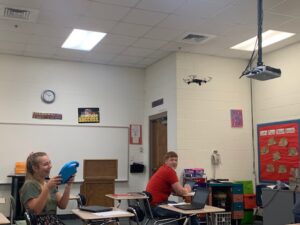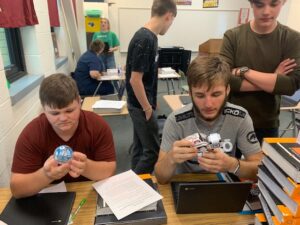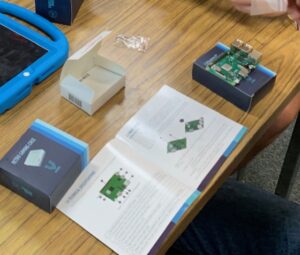In This Post:
- Four new tech tools to try out in your classroom.
- Ideas and strategies to use these new tools well.
We’re not quite living in The Jetsons time period (2060s), but our technology is getting closer and closer to mimicking the 1960s cartoon. Research has shown that nearly 70 percent of all jobs are in the technology sector. As technology becomes more affordable and widespread in schools, our students have more and more opportunities to experience these technology advances in real life.
As technology becomes more affordable and widespread in schools, our students have more and more opportunities to experience these technology advances in real life. Share on XThe beginning of this school year was super exciting as my classroom was fortunate to receive a Donor’s Choose Grant to purchase two Parrot Mambo Drones, a Cosmo, Sphero, and a Raspberry Pi. My class is still experimenting with these awesome tools, but as a teacher I love what they have brought into my classroom. Check out these four new tech tools to love!
Tech Tool To Love #1: Drones
 Drone technologies are becoming more affordable and more complex. With the level of complexity, colleges now have drone programs. Drones are used in a variety of industries including agriculture and construction and can be easily purchased from websites like Amazon or DrDrone.
Drone technologies are becoming more affordable and more complex. With the level of complexity, colleges now have drone programs. Drones are used in a variety of industries including agriculture and construction and can be easily purchased from websites like Amazon or DrDrone.
In my classroom, my students have been experimenting with basic drone operation and coding. They did this work on the Parrot Mambo drone. While they love to manually fly the drones, students challenged themselves to code the drone to fly to the office on the other side of the school building. They discovered the drone loses connection to the iPad with the code about half way down the hall. We’re still trying to find ways to make the connection stronger to complete the task of flying to the office and back.
Students are also in the process of compiling their research and creating a flight manual for the Parrot Mambo drone. See their work in progress.
Drones have created a fun and exciting classroom as we’re learning the concepts of technical writing.
[scroll down to keep reading]Tech Tool To Love #2: Cosmo
This cute little robot has personality, even before you code it. Cosmo has a built in camera so the user can see the world from its point of view. The robot can talk, dance, stack blocks, and complete a variety of different tasks.
can see the world from its point of view. The robot can talk, dance, stack blocks, and complete a variety of different tasks.
My students code Cosmo to say their name through the facial recognition software installed. A user can code the robot or manually move and prompt the robot to complete a variety of tasks. My high school students love Cosmo and I’m sure your students will love him too.
Tech Tool To Love #3: Sphero
This durable ball shaped robot is amazing. Students can manually drive it through obstacles in addition to coding it through a maze.
Sphero Education is downloadable to Chromebooks so multiple students can be working on programming, and then test their code on our Sphero.
After our novel units, I plan to have students create novel themed parade “floats” that will be powered by Cosmo and Sphero. If I would have known how much we’d love our Sphero, I would have requested more than one.
Tech Tool To Love #4: Raspberry Pi
 This compact computing device has so much potential. My students have just began to look into specific projects they would like to complete.
This compact computing device has so much potential. My students have just began to look into specific projects they would like to complete.
For example, they have found plans to create a security camera that is triggered by motion sensors. Another class is looking into the possibility of purchasing a variety of weather sensors to monitor the weather. One group of students has already figured out how to use the Raspberry Pi to play and create retro arcade games.
This tool holds a wealth of possibility. The creativity my students have will no doubt shine, mainly because of the huge variety of ability Raspberry Pi provides.
I feel it’s important to note that these technology tools are being used within the English classroom. Students write about their experiences, what works and what fails in addition to what they are learning. These four tech tools brings a love of learning everyday in my classroom.
About Jeremy Rinkel



